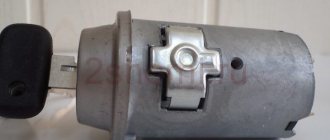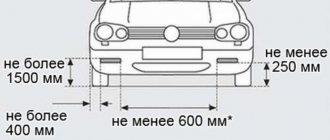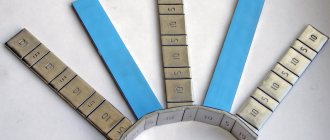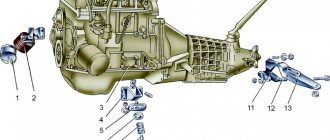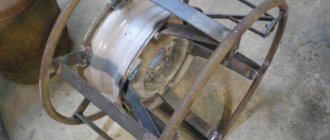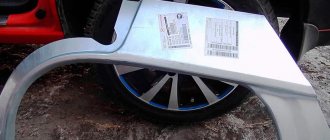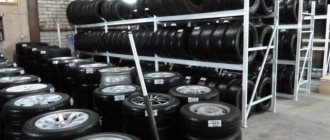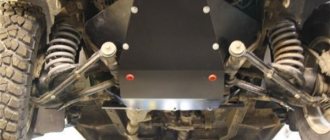Most car owners suffer from lack of space in the garage. A small room does not even allow for proper storage of seasonal tires. But it is necessary not only to preserve it, but to do it correctly, otherwise even new tires can be ruined in just one season of improper conservation. A tire storage rack can be an excellent solution to the problem. Such a structure will not only significantly save space, but will also contribute to the harmless preservation of the wheels.
You can buy this design or make it yourself. If you have the finances and no time to prepare materials and assemble, then the easiest way is to purchase a rack in a specialized store. But if you have the time and desire to create a quality thing, then you need to boldly get down to business.
Rack for car wheels
Rules for storing car wheels
Not every car owner knows that they need to follow the rules for storing wheels, otherwise they quickly become unusable and can fail at the most inopportune moment. Different sets of tires have specific storage conditions, but general rules can also be identified, the observance of which will be relevant in any situation:
- Do not store wheels near heating or cooling devices. Significant temperature changes occur near them, which cause condensation to accumulate and deformation of the rubber.
- Make sure that the wheels are not exposed to moisture, oil or acidic liquids.
- Store tires in a cool, dry place.
- If the wheels are wrapped in film, do not forget to periodically remove and ventilate them. Otherwise, dampness will begin to accumulate inside, which will negatively affect the material in the future.
Now let's look at the individual storage features of different sets.
Summer tires
Summer tires are made from materials whose composition is different from winter tires, and accordingly, the storage conditions will be different. The peculiarity of storing summer tires is that the room temperature should be kept around 20 o, with a relative humidity level not exceeding 60%. Small deviations from these indicators are acceptable.
Winter tires
Winter tires do not tolerate high temperatures well. Therefore, beware of installing racks and fixtures for storing it in:
- rooms with high temperatures;
- places exposed to direct sunlight.
On disks
Storing wheels on disks adds additional nuances to the preservation process. The thing is that when stored vertically, the tires, under the influence of the weight of the rims, will begin to deform. This will reduce their quality of adhesion to the road surface, which can lead to an emergency situation.
It is recommended to store assembled tires in a horizontal position, on top of each other, or suspended on a rope that is threaded through the center of the disk.
Note! When storing tires for the winter, they must be well inflated. The pressure inside the wheels should be working or slightly below normal.
No disks
If you store tires separately from wheels, follow these rules:
- keep them upright;
- once a month, rotate the tire 20-180 o;
- It is allowed to store the wheels in a suspended state, stringing them on a rope or metal cable.
Design features
Diagrams and design drawings for tire maintenance can satisfy any requirements of the car owner. It can be:
- racks and shelves of various configurations;
- hooks and stands;
- specialized cabinets in which you can create your own microclimate, ideal for keeping a particular set of tires in the garage.
Some of them are universal and suitable for any tire, others are highly specialized and designed for special conditions.
Racks and shelves
A rack for storing wheels in a garage gives the owner the following advantages:
- the ability to equip a rack with wheels with additional shelves designed for various tools;
- depending on the size of the garage and the amount of free space, the size and shape of the stand can be easily adjusted during assembly;
- the design has a large margin of safety at a relatively low cost.
Hooks and stands
Convenient devices for storing wheels in the garage, with the following advantages:
- easily and quickly made independently;
- take up little space and can be placed in any free corner of the garage;
- the stand, unlike a shelf or rack, can be easily moved from place to place and, in case of repair, it does not need to be dismantled or disassembled;
- materials for their manufacture are readily available and relatively cheap.
Note! Wheel hooks can be made as permanent brackets that attach to the wall, or as a removable piece that can be hung from a metal cable or rope, which is very convenient.
Specialized cabinets
If there is desire, time and money, the garage owner can equip the room with a special cabinet for storing wheels. Advantages of cabinets:
- the design does not spoil the appearance of the room;
- placed in any free space. It is not necessary to install it on the floor; you can make special fastenings and hang it on the wall;
- storing the wheels in a special cabinet will ensure that a jar of oil or other liquid that is in your garage will not accidentally be knocked over on them. This will significantly extend the life of the tires.
Description
Designs that improve storage include wheel racks, shelves or wall hooks. All these devices are made of metal or wood, they are presented in the form of a solid base - a frame, and the device itself usually takes the form of a stationary rectangle of five frames connected to each other.
To avoid accidental falls of the structure, special fastening points are installed on the walls. The stand for wheels differs in that it is possible to move it around the room. Externally, they are very similar - the stand looks like a shelf with legs or like a metal stand.
When installing hanging shelves, much attention is paid to the supporting parts, because the weight of such a structure (together with tires) is very large. Car wheel hooks look like metal pins on the wall.
Many car owners who have free time and money install a specialized wheel cabinet in the garage. This design can be placed not only on the floor, but also on the wall, which will help to significantly save space. You can also create an optimal microclimate for rubber in the cabinet. The risk of dirt and dust getting in or an accidentally knocked over can of oil is minimized.
When choosing a way to store wheels, you need to consider whether they will be placed without rims or with rims.
Making a wooden rack with your own hands
Despite the abundance of different designs or devices, not every vehicle owner has the opportunity to spend money on such purchases. The solution in this situation would be to build a wooden rack in the garage, which will require a minimum of costs and will last no worse than its metal counterpart.
Construction consists of the following stages:
- preparation of tools and materials;
- cutting material according to selected drawings;
- assembly and installation of the structure.
These simple steps will help you store wheels in your garage correctly, without damaging them or cluttering the room.
Preparatory work
Preparatory work before constructing the rack consists of the following steps:
- search for suitable drawings;
- preparing the required amount of materials for their implementation;
- preparation of tools. Among them must be: a hammer, a tape measure, a saw or a hacksaw, a level, a screwdriver or a screwdriver, a corner;
- preparing the site for the construction of the structure. It needs to be cleared of debris and filled with concrete if the floor in the garage is not level;
- It is advisable to treat the wood with chemical compounds that prevent rotting and mold formation.
Cutting material according to drawings
The cutting system depends on the complexity of the selected drawing. The number of steps required for cutting may vary.
The basic sequence of actions is as follows:
- We prepare the racks. For one section, the width of which is 1 meter, 4 racks are required. It is not recommended to build a rack whose width exceeds 1.5 meters. Wooden shelves will not be able to withstand the load and will begin to sag in the center. This will negatively affect both the durability of the structure and the condition of the stored wheels.
- We cut off the bars of the required length, which will act as a connecting element of the rack.
- Cut out the shelves. A 150 x 40 mm board or chipboard is suitable as a material for shelves.
Assembly and fastening of the frame
Assembly and fastening are carried out in accordance with the drawing. When assembling the structure, consider the following nuances:
- Assembling a permanent structure begins with attaching the racks to the rear wall of the garage.
- In some cases, the rear wall of the rack will be reinforced with special spacers.
- Elements of the rack that come into contact with the tires must not have corners or irregularities. Otherwise, they will deform the rubber, and you will have to purchase a new set.
Shelves for storing heavy items
How to make a dog house with your own hands: arrangement of housing in the yard and in the apartment. Drawings, dimensions and original ideas (55+ Photos & Videos) + Reviews
Metal shelving
Typically, metal shelves are used to store very heavy items or items with large dimensions. To securely store things on them, it will be better if they are made as stationary structures.
This approach immediately eliminates bolts as a connecting element. You can buy stationary metal products, the connections of which are provided using various grooves and guides, but this will no longer be an independent production, in addition, such structures are very expensive.
Therefore, it is recommended to use welding to create entirely metal shelves. The use of bolts is allowed in non-critical joints, or where they are assigned the role of fastening light elements.
Metal rack
- As usual, manufacturing begins with the creation of a drawing or sketch. In this case, their location plays an important role. It is advisable to place such products near strong, solid walls. It is possible that a significant part of the load when attaching the rack to the wall will fall on the wall, and if it is of a decorative nature, unpleasant incidents are possible.
- For such shelves, it is best to choose not square profiles as frame elements, but ordinary corners, but with dimensions of at least 50 mm. Often the creation of such products is made not from a frame, but from a wall mount.
- The frame elements are first marked and cut out using a grinder, and then welded into a single structure using a welding machine. At all stages, you should check the right angles of the rack elements: between the racks, crossbars and fasteners.
Frame for metal shelves
- The shelves themselves are made of perforated or rolled steel with a thickness of 1 to 5 mm. Its thickness is determined solely by the desire of the owner.
- At the same time, one should not forget about the weight of the structure. A sheet of rolled steel with dimensions of 50x100 cm and a thickness of 3 mm weighs almost 12 kg, and a sheet with the same dimensions and a thickness of 5 mm weighs almost 20 kg. In addition, do not forget about the cost: a sheet measuring 1000x500x3 mm will cost about 2-3 dollars.
- An alternative would be to use wooden shelves. In this case, you should choose wood with a thickness of 2.5 to 3 cm, which will first need to be treated with a fire retardant to increase its fire resistance.
- These boards can be connected to the frame using bolts. Metal sheets are also attached to the boards with bolts or self-tapping screws. In this case, it is better not to use welding so as not to destroy the wooden elements.
Upon completion of the work, the entire structure must be cleaned of rust and painted.
Where is the best place to place tire racks?
It is advisable to place racks for storing wheels in your own garage away from the entrance, securing them properly on one of the walls. There the temperature is most stable, and the tires will not be subject to such changes as near the gate.
Design the rack so that the tires are 5-10 centimeters from the wall. It is advisable to move oils and other technical fluids to the opposite corner of the garage to avoid unnecessary contact with rubber.
Garage projects
- 31.8² Total area
- 6 x 5m Construction area
- 60² Total area
- 6 x 12m Construction area
- 40² Total area
- 8 x 5m Construction area
- 31.8² Total area
- 6 x 5m Construction area
- 58² Total area
- 10 x 6m Construction area
- 2 rooms
- 1 bathroom
- 105.8² Total area
- 12 x 6m Construction area
- 11.7² Total area
- 3 x 4m Building area
- 76.95² Total area
- 8 x 11m Construction area
- 40.6² Total area
- 6 x 7m Construction area
- 89.79² Total area
- 12 x 7m Construction area
- 33² Total area
- 6 x 6m Construction area
- 23.1² Total area
- 3 x 7m Construction area
- 31.8² Total area
- 6 x 5m Construction area
- 11.7² Total area
- 3 x 4m Building area
- 27² Total area
- 6 x 6m Construction area
- 37² Total area
- 10 x 5m Construction area
- 20.6² Total area
- 6 x 4m Construction area
- 31.8² Total area
- 6 x 5m Construction area
- 36² Total area
- 6 x 6m Construction area
- 42² Total area
- 6 x 7m Construction area
This article will be useful for any car enthusiast, because it will talk about proper storage of tires using devices such as a wheel rack in the garage. This addition is very convenient and practical, in addition, it will protect spare parts from damage and falls. In addition, like other tools and materials, automotive components and assemblies must be placed not on a concrete floor, but on special shelves. After reading the text, you will learn about the conditions under which tires should be stored, what kind of shelves and other accessories there are for wheels in the garage, and how a rack for storing tires is made.
Floor Mounted Tire Storage Rack Design
Metal rack for vertical storage of wheels
The reliability and durability of metal structures is higher than wooden ones. The use of metal and its profiles will allow you to make a practical tire rack.
What materials will you need?
Before starting work, prepare the following materials:
- corner size 35–50 mm;
- profile pipe of rectangular cross-section, say 40x15 mm or similar;
- To ensure rigidity, additional spacers from a profile strip with a width of 35–50 mm are used.
If you do not have a welding machine, you will need mounting bolts with nuts and washers. The threads must withstand the load, so it is recommended to use the M8 connection size.
ATTENTION! For ease of making connections, the rectangular pipe is selected in such a way that one side corresponds in size to the size of the corner.
Prepare the necessary tools
To assemble the required structure you will need:
- grinder with cutting discs;
- screwdriver;
- measuring and marking tools;
- welding machine with electrodes;
- drill;
- hammer and plumbing kit.
Preparing the components of the rack
Before starting assembly, the material is cut into blanks that will be used in the manufacture of the rack. Depending on the required dimensions of the product indicated in the drawing, corners and rectangular pipes are cut into sections used as racks, longitudinal rails and stiffening crossbars. For ease of installation, the workpieces are laid out depending on the difference in size.
Assembling a rack with your own hands
After preparing the material, they begin to assemble the structure.
- First, the joints of the parts are marked and the side posts are welded. The vertical supports are made from a corner, and the crossbars are made from a rectangular profile pipe. If the shelves are hanging, then the racks will have a trapezoid shape, and for a regular floor rack, they look like a ladder with a small number of steps.
- At the designed height, the longitudinal slats are welded first to one rack and then to the other. The material of the shared supports must be durable, so a corner is used.
IMPORTANT! The tires will rest on the longitudinal rail. To avoid deformation of the rubber, it is recommended to turn the corner so that the wheels touch the flat surface of the profile. Or use a round profile for longitudinal supports.
- The presence of a large length or height may compromise the rigidity of the product under load. To prevent this from happening, the structure is reinforced with diagonal or transverse stripes, which will not interfere with the placement of tires.
- When the finished structure is placed on the floor, metal “nickels” are welded under the support posts. Such supporting planes will not allow the rack to sag when fully loaded with wheels. Wall mounting will require mounting on hooks or using brackets with dowels.
Before installing the product in the required location, the metal surface is primed several times and then coated with paint.
Preparatory work
Zoning
Before starting design, it is necessary to resolve the issue of zoning and organization of free space
First of all, it is important to determine the location of the main work areas, after which it will not be difficult to find the optimal options and sizes of shelving. Recommended distribution of garage zones:
Recommended distribution of garage zones:
- Always a free passage area.
- An easy access area where the most frequently used items and things are located.
- The place where everything is thin, tall and long. The optimal location of such items is vertical.
- Area for large tools and equipment.
- Workplace. Equipped with machines and devices.
Design
The process of making a rack begins with design.
First of all, you need to prepare a drawing that can be done by hand. It should indicate:
- geometric parameters of shelves;
- distances relative to walls and ceiling;
- dimensions of each element.
Racks with open shelves are most convenient for the garage. It is recommended to give preference to simple shapes and strict lines. The width of the shelves is chosen so that all the things that are planned to be stored in this place fit. The height of the rack can be different, up to the ceiling. Such massive structures are stationary and firmly attached to the walls and upper ceiling.
At the design stage, they decide what will be the method of connecting the parts. Several options are possible:
- welding;
- bolted connections;
- screws and nails (for wooden structures);
- using metal corners and plates.
It is necessary to choose the correct distance between shelves. The lower ones are made more spacious, since the heaviest things, which can be large, are most often placed on them. If there are no such items at the moment, they may appear in the future.
Next, determine the depth of the niches, which corresponds to the width of the shelves. Too narrow are impractical, too wide - inconvenient to use. Practice has shown that the optimal depth of niches is 50-60 cm. The length of the shelves is equal to the distance between the support posts
If the rack is wooden, it is important to prevent the boards from bending under load. In this regard, the optimal shelf length is 100-120 cm
Metal racks make them wider.
Measurements and markings
Not only the appearance of the finished product, but also its strength and reliability depends on how correctly the measurements are taken. Even small distortions can cause breakage and collapse of the structure - this applies to a greater extent to wooden shelving.
Measurements are taken using a tape measure. The length of the tape must be at least 5 meters. A laser level, through which the horizontal and vertical lines are found, will provide invaluable assistance. It is extremely necessary when performing markings.
On the walls and/or ceiling, use a marker to mark the location of the main elements of the future structure
This is especially important when installing stationary shelving. When manufacturing elements (shelves, support posts), be sure to check the markings made
What can you make a rack for storing wheels from?
The raw materials from which the shelves are made must be durable and able to withstand the weight of tires and rims. Based on the type of materials used, the racks are distinguished:
- metal;
- wooden;
- combined.
After putting things in order in the garage, you can find unclaimed blocks of wood or long-abandoned metal profiles that are used to make shelves. If there are none, you need to select and purchase the desired material.
ATTENTION! Tires and rims are heavy, so the material chosen must be strong enough to accommodate the maximum amount of rubber on the shelf.
Possible drawings of racks for wheels
Storage products are distinguished by type of design:
- floor;
- wall;
- hanging.
For vertical placement of tires, frame racks are used, and tires with rims are laid horizontally on shelves.
Before making any design, even a very simple one, a sketch is made. The rack is designed for vertical storage of tires without rims. The drawing includes the dimensions of the product, as well as the distance between the individual frame elements.
Takes into account the radius of the wheels that will be stored - this affects the size of the transverse beams connecting the vertical posts. The sketch reflects the number and length of longitudinal slats, depending on the number of intended products that will be stored on the rack.
REFERENCE! The standard executive dimensions are considered to be a height of 2 m and a width of 1.5 m. But if the room conditions or user requirements do not allow these values to be observed, then this is not a violation of the design, but only individual characteristics.
Drawings of shelves for wheels
When designing a temporary horizontal arrangement of tires, the sketch provides for such a width that will allow the rubber to lie firmly on the surface. This storage method is used for tires with rims. The height between the shelves is made larger than the width of the wheels that will be stacked on it, while the number of stacked products is recommended to be no more than two. The dimensions of the structure must be larger than the tire parameters and allow free use of the internal space for storing tires.
Metal rack for vertical storage of wheels
The reliability and durability of metal structures is higher than wooden ones. The use of metal and its profiles will allow you to make a practical tire rack.
What materials will you need?
- corner size 35–50 mm;
- profile pipe of rectangular cross-section, say 40x15 mm or similar;
- To ensure rigidity, additional spacers from a profile strip with a width of 35–50 mm are used.
If you do not have a welding machine, you will need mounting bolts with nuts and washers. The threads must withstand the load, so it is recommended to use the M8 connection size.
ATTENTION! For ease of making connections, the rectangular pipe is selected in such a way that one side corresponds in size to the size of the corner.
Prepare the necessary tools
- grinder with cutting discs;
- screwdriver;
- measuring and marking tools;
- welding machine with electrodes;
- drill;
- hammer and plumbing kit.
Preparing the components of the rack
Before starting assembly, the material is cut into blanks that will be used in the manufacture of the rack. Depending on the required dimensions of the product indicated in the drawing, corners and rectangular pipes are cut into sections used as racks, longitudinal rails and stiffening crossbars. For ease of installation, the workpieces are laid out depending on the difference in size.
Assembling a rack with your own hands
- First, the joints of the parts are marked and the side posts are welded. The vertical supports are made from a corner, and the crossbars are made from a rectangular profile pipe. If the shelves are hanging, then the racks will have a trapezoid shape, and for a regular floor rack, they look like a ladder with a small number of steps.
- At the designed height, the longitudinal slats are welded first to one rack and then to the other. The material of the shared supports must be durable, so a corner is used.
IMPORTANT! The tires will rest on the longitudinal rail. To avoid deformation of the rubber, it is recommended to turn the corner so that the wheels touch the flat surface of the profile. Or use a round profile for longitudinal supports.
- The presence of a large length or height may compromise the rigidity of the product under load. To prevent this from happening, the structure is reinforced with diagonal or transverse stripes, which will not interfere with the placement of tires.
- When the finished structure is placed on the floor, metal “nickels” are welded under the support posts. Such supporting planes will not allow the rack to sag when fully loaded with wheels. Wall mounting will require mounting on hooks or using brackets with dowels.
Before installing the product in the required location, the metal surface is primed several times and then coated with paint.
Do-it-yourself wheel rack for the garage
Storing one set of tires does not require the manufacture of a standard rack that can accommodate several dozen tires.
Depending on the individual characteristics of changing wheels (with or without disks), the consumer allocates space inside the garage.
Considering the small size of the buildings that car owners have to use, it is recommended to install a shelf or wall-mounted rack.
The raw material can be used timber or an unclaimed metal profile that can be found in the garage. The shelf material can be combined, for example, the side posts are made of iron, and the longitudinal slats are made of wood, or vice versa. In the absence of welding skills, as well as for connecting iron products with beams, bolted connections are used.
ATTENTION! Before using wooden elements to make a frame structure, you must make sure that they have retained their strength properties and treat them with an antiseptic.
Using a self-made rubber storage rack will bring the car owner not only cost savings, but also moral satisfaction, thanks to the opportunity to contemplate his own product.
Rack for horizontal storage of wheels
The sequence of work is similar to assembling the rack. The difference is that the longitudinal slats are replaced with sheet material, and the height between the shelves corresponds to the width of one or two wheels, depending on the design solution. To save space, such products are often wall-mounted or hanging.
Wooden shelves with metal frame
Rack with metal frame
An alternative design option, which is a more expensive, but at the same time more durable and durable solution. The racks in these shelves are made of metal, and the surface of the shelves itself is made of wood or any materials of wood origin.
Such a rack has a higher resistance to moisture and mold. It is more resistant to heat and fire. Moreover, by using metal parts, they can be made dismountable, which will allow you to change the appearance of the structure according to any desire of the garage owner.
Materials and tools needed for work
Corners for shelving in the garage
The racks of such a rack are made from rectangular pipes or from a profile with a width of one of the sides of 5 cm. A 30 mm corner is best suited as crossbars.
The frame is made from a corner, and the thickness of the shelf should be from 1.5 to 3 cm (along the height of the corner). Crossbars made from angles can be attached to the guides in different ways - by welding or using bolts. It all depends on the wishes of the owner.
If you need a durable structure, then welding is preferable; if you require the versatility of the product with the possibility of its further modernization, you should use bolts. The use of bolts allows, for example, to change the height of each level.
Shelves can traditionally be made from any material on hand - from pine to OSB. For reasons of strength, their thickness should not be less than 12-15 mm.
For work you will need the following set of tools:
- drill (screwdriver)
- Bulgarian
- wood hacksaw
- corner
- level
- welding machine (optional)
Manufacturing procedure
Do-it-yourself drip irrigation device in a greenhouse: from a barrel, a plastic bottle, or even an automatic system. For tomatoes and other crops (Photo & Video)+Reviews
Corner shelving frame
It is best to assemble the rack in a free room, and it is advisable to empty the garage of unnecessary things and remove the car from it.
After assembling the frame, it should be screwed to the wall. The assembly sequence is as follows:
Based on the finished measurements, the material of the racks and corners for the shelves is cut using a grinder. The racks are marked in those places where shelves will be attached to them. The corners are screwed to the racks using bolts (or welded in the case of a stationary structure)
In this case, it is extremely important to maintain a connection angle of 90°, otherwise the structure will turn out skewed. Similarly, the racks are connected to each other using crossbars, but at the same time, right angles must be maintained not only between the racks and crossbars, but between the crossbars and the previously attached corners. The assembled structure is installed on its place and screwed to the walls and floor. This can be done, for example, using anchor bolts. The metal frame is sanded using a grinder with an appropriate brush attachment and coated with a primer or paint containing a primer. At this stage, in order to facilitate the labor-intensive process of mechanically cleaning the frame from rust, you can use a chemical rust converter
Typically, converters require a day to dissolve the rust; after which it is possible to paint the surfaces without any mechanical or chemical treatment. After the paint has dried, shelves are cut out of wood or wooden materials and adjusted in size to the finished frame structure. The shelves are sanded, painted or varnished, and then attached to the frame using bolts or self-tapping screws
At this stage, in order to facilitate the labor-intensive process of mechanically cleaning the frame from rust, you can use a chemical rust converter. Typically, converters require a day to dissolve the rust; after which it is possible to paint the surfaces without any mechanical or chemical treatment. After the paint has dried, shelves are cut out of wood or wooden materials and adjusted in size to the finished frame structure. The shelves are sanded, painted or varnished, and then attached to the frame using bolts or self-tapping screws
Standards for storing wheels on rims and tires in the garage
Since tires and tires can withstand sudden changes in temperature, they can be stored at -30 and up to +35 degrees. It is highly recommended not to install shelving or hang hooks near heating appliances. The ideal option is to install racks at a distance of about 1 meter from heating devices and radiators.
How to organize the system correctly?
It is best to make special racks for storing complete wheels and tires. When making such a rack, make sure that its surface is perfectly flat and without any protruding corners.
Also, many car enthusiasts store tires in the garage simply on the floor. This is not the best way, but if you have nowhere to hang a rack in the garage, then the main thing is to put the tires on a flat floor.
It is advisable that the floor in the room be made of concrete, wood or have a good rubber coating. Standard tires up to 205 mm can be stacked on top of each other. Larger tires should be stacked vertically in rows.
The height of the tire stack should not exceed 2 meters.
Tires should not be exposed to direct sunlight or ultraviolet rays. Since their strength will weaken significantly under such influence, and microcracks will appear on the tires. Tires should be rotated every three months. Then they will not succumb to constant stress and deteriorate.
Storage of wheels and tires according to GOST
Storage of winter and summer tires must comply with a certain temperature and light conditions. To keep your tires looking like new, you must follow these rules:
- Wheels on rims must not come into contact with copper products;
- Gasoline fumes and ozone are harmful to rubber;
- storage temperature – from -30 to +35 degrees;
- sudden temperature changes are undesirable;
- the rack must be level, without sharp corners, which can cause deformation of the rubber during long-term storage;
- tires up to 205 mm can be stacked, but not higher than two meters;
- large wheels above 215 mm are stored only in a vertical position, arranged in rows;
- direct sunlight has a bad effect on the strength and durability of rubber;
- wheels can be stored outdoors for no longer than a month; in extreme cases, you can build a small shed if there is no space for shelving in the garage;
- cover the wheels on the rack with a piece of tarpaulin or thick film to avoid contact with oil and caustic solvents;
- High humidity in an unheated metal garage has a bad effect on rubber and metal.
Important. Wheels on rims that are stored for a long time should be turned over once every three months to avoid deformation.
If you store tires and rims correctly, then you won’t have to spend money on re-flashing at the beginning of the season.
Possible drawings of racks for wheels
Storage products are distinguished by type of design:
In the garage
Storing tires in a garage is the best option if the room is brick and well heated. The fact is that high humidity will inevitably lead to damage to products, so using tires at the beginning of the season becomes impossible and even dangerous.
The most suitable temperature for preserving rubber is from +100 C to +250 C, so an unheated garage will not be suitable for this purpose.
WATCH THE VIDEO
The advantage is the lack of sunlight. However, car chemicals that destroy rubber (oil, gasoline) are stored in garages.
On the balcony
Proper storage of tires according to GOST is not permitted outdoors. If the balcony is not glazed, the wheels must be covered with protective material. This protects them from the destructive effects of ultraviolet radiation. Rubber dries out in sunlight and microcracks appear on it, so it can burst during use.
In frosts below -300 C, it is better to move the wheels to another room.
Cellar
If there is no other place, then the tires can be lowered into the cellar. The main thing is that the room is dry and the optimal temperature is maintained.
Simple DIY tire rack
A tire rack in a store costs from 5 to 8 thousand, depending on the number of shelves. You can make such shelves with your own hands for a maximum of one and a half thousand. The simplest rack is wooden, but it is short-lived and susceptible to mold. This must be taken into account.
Wooden tire rack
You should immediately select the location for installing the wheel storage rack and take the dimensions (height, width and depth). The place for the rack should be far from gates and heating devices. Now let's start preparing the installation site:
- you need to level the concrete base, knock off the protrusions and concrete the uneven areas;
- it is better to make a small concrete screed according to the size of the rack, this will ensure the stability of the structure;
- We draw a drawing with all dimensions, taking into account the shelves (the number that is needed). The drawing is needed to correctly calculate the required amount of material for the rack;
- materials needed for work: timber (50x50 or 50x70 for the frame or edged board 150 x 40 or 150 x 50), shelf flooring can be made of chipboard, edged board, thick plywood or OSB);
- For the work you will also need wood screws, length to fit the timber, a screwdriver and metal corners, nails, a hacksaw and a hammer. We check the corners with a water level or a square;
- For a rack on wheels, we purchase four wheels (sold in furniture stores), you can separately buy a metal frame with wheels.
Important. The timber and boards must be dried, treated with antiseptic impregnation against mold and painted.
Assembly sequence
Assembling the timber is easy:
- one section requires four racks so that the rack can support the weight of the wheels;
- the step between the vertical posts is one and a half meters, no more, so that the shelf does not bend;
- first you need to cut the timber or board according to the drawing, and then start assembling;
- Draw the future structure on the wall with chalk, this will make it easier to assemble the frame and shelf parts;
- if we are not making the back wall, then the vertical beam can be fastened directly with screws and dowels, this is more reliable, and then the entire frame can then be aligned along stable guides;
- we assemble the structure, additionally strengthen all the joints of the timber with metal corners;
- The height of the shelves is taken based on the height of the tire plus 10 cm.
Advice. If the tire storage rack is on wheels, then install a spacer diagonally on the longest side of the rack to stiffen the frame. A 5 mm metal cable, which is attached crosswise to the back wall, is also suitable for this.
To store tires, you can implement a simpler solution - drive in metal hooks and hang tires on them. The disadvantage of this option is that many wheels in this case will not fit in the garage.
It is advisable to cement the hooks, since over time they become loose under the weight of the wheels on the rims and fall out. To avoid damaging the wheel, the hook can be wrapped in soft cloth and secured with electrical tape.
Another interesting option for storing wheels is to hang them from the ceiling on a strong rope and place them along the wall, as in the photo.
Hanging shelves: fast and practical
Not in all cases there is a need to create a rack, since it will take up a lot of space. On the other hand, in a garage of any size there is always unused upper space, which can easily be used for hanging shelves.
Structurally, it is quite possible to make any version of such a device for the garage with your own hands:
- Wall shelves can be equipped in both open and closed versions. They are convenient due to their spaciousness, as well as ease of construction. They can be hung on a loop or using an anchor. In the first case, a collapsible structure is obtained, the location of which can be conveniently changed at any time. In the second, the shelf gains additional strength due to the reliability of its installation with the wall.
Hanging shelves are attached to the ceiling. Due to the peculiarities of their location, they occupy exactly that part of the space that is not used and do not interfere with the car at all. The disadvantages of the design include its lack of reliability - it can sway a little upon contact. However, for small items (hammer, pliers, screwdriver, paint, etc.) it will do just fine.
An interesting option for storing tools is to make one wall or a fragment of it in the form of a shield. The shield is attached using anchors, and then small shelves are selected and mounted on it.
You can also build a shield yourself from wooden beams, as shown in the photo.
To store large items of small weight, you can design hanging shelves that are attached to the ceiling using studs.
To make these devices for placing useful items in the garage with your own hands, you will need the following materials and tools:
studs and shelf base - most often plywood or chipboard is used, the thickness of which depends on the expected loads;
large anchors (at the rate of 4 units per 1 shelf);
hexagonal and regular nuts;
flat washers and special Grover washers (at the rate of 4 units per 1 shelf.
The tools you will need are the standard set described above. The sequence of actions is as follows:
- Shelves of appropriate sizes are calculated and cut out. It is better to immediately treat them with primer and varnishes and let them dry completely.
- Markings are made on them for fastening. If the shelf is long, the supporting supports should be placed at a distance of no more than 60 cm.
- It is better to reinforce the ends of the plywood with a metal profile to ensure maximum reliability of the structure.
- The edges are marked with grooves into which the studs will be mounted. They should be placed at least 5-7 cm with a margin from the edge so that the wood does not crumble during prolonged loads.
- All grooves and holes are drilled, then future fastening locations are marked along the wall and/or ceiling.
- The holes on the wall are also drilled, after which the anchors are inserted into them all the way.
- The studs are connected to the anchors, as shown in the photo.
Finally, the shelf itself is put on and secured using regular washers and Grover washers. The level checks the correct location and makes adjustments if necessary.
The entire technology is shown schematically in the figure.
Making a shield shelf
The DIY technology for making such a device for a garage has its own differences compared to installing conventional shelves:
- The shield itself is made of durable plywood, the parameters of which are selected according to the situation. Visually, the shield should completely cover the surface of the desktop.
- Space is allocated on the board for all shelves and appropriate notes are made.
- Next, all the holes into which the dowels fit are made in the surface of the structure. It is on them that the hooks will be attached, on which all the tools will be placed.
- The shield is secured to the wall using brackets. The corresponding holes are made using a hammer drill.
All steps are shown schematically in the figure.
Rack for horizontal storage of wheels
Tires that are not separated from the rims can be stored horizontally.
The manufacture of shelves for such placement is distinguished by the possibility of using sheet material as a raw material and a smaller height, which is especially important in limited space. The sequence of work is similar to assembling the rack. The difference is that the longitudinal slats are replaced with sheet material, and the height between the shelves corresponds to the width of one or two wheels, depending on the design solution. To save space, such products are often wall-mounted or hanging.
Dimensions
Standard shelf dimensions for 4 rubber wheels:
- height – 200 centimeters;
- length – 150 centimeters;
- width – 80 centimeters.
The rack is installed from the wall surface at a distance of 10-20 centimeters - this is done so that the rubber does not touch the surface. Two parallel beams (metal or wood, it all depends on the material of manufacture) are mounted a meter from the floor - this is a shelf for tires. The upper and lower parts of the rack can be covered with any material - for example, wooden boards, plywood. These shelves are convenient for storing various tools or car parts. When installing the frame, you should remember that the wheels rest on the longitudinal beam during storage.
Do-it-yourself wheel rack for the garage
Storing one set of tires does not require the manufacture of a standard rack that can accommodate several dozen tires.
Depending on the individual characteristics of changing wheels (with or without disks), the consumer allocates space inside the garage. Considering the small size of the buildings that car owners have to use, it is recommended to install a shelf or wall-mounted rack. The raw material can be used timber or an unclaimed metal profile that can be found in the garage. The shelf material can be combined, for example, the side posts are made of iron, and the longitudinal slats are made of wood, or vice versa. In the absence of welding skills, as well as for connecting iron products with beams, bolted connections are used. ATTENTION! Before using wooden elements to make a frame structure, you must make sure that they have retained their strength properties and treat them with an antiseptic.
Using a self-made rubber storage rack will bring the car owner not only cost savings, but also moral satisfaction, thanks to the opportunity to contemplate his own product.
Overview of species
Depending on the installation method, there are 3 types of racks for storing rubber in the garage.
Depending on the tire placement option, there are:
Racks also differ in the material they are made of.
Metal
Such structures are installed in the garage, on the balcony or in any utility room. In addition to tires, you can place tools or car parts on a metal rack; this design is universal. Store-bought devices are very easy to assemble and adjust in height.
Wooden
Shelves made of wood are usually homemade structures. In the case of wooden models, you need to remember that wheels with discs are heavy, so the material must be strong enough. Wooden blocks can be purchased in the store, or you can take “abandoned” existing materials.
How to properly store tires on rims: standing or lying down
However, practical motorists have long realized that it is better to have both sets of tires, winter and summer, on rims. So that, when the time comes, you can simply swap one wheel for another and pump them up to the required pressure. Any male neighbor can do this. An essential point that makes the life of a car lady easier, by the way.
Useful advice Before the seasonal crowds in tire shops occur, it is more than advisable to check the wheels. It's worth taking the time to take a set of wheels there. An inspection, which includes checking for defects and balancing, will protect you from troubles on the road and save life and health.
We have already decided that assembled wheels are more convenient to use. This also applies to ease of storage.
- The wheels are laid one on top of the other on a flat floor, but no more than 4 pieces. High stacks that are stored for many months will destroy the lower tires.
- Or hung on wide, strong slings or ropes from hooks on the ceiling or metal rods on the walls. They are specially equipped with garages or sheds. Suitable for underground storage, where the temperature does not drop below zero degrees and there is no humidity.
Hanging car shoes on disks in a dry shed or garage is preferable. This prevents damage to the main material of the tire - rubber and ensures good ventilation. And the main weight of the wheel is taken by the metal disk.
Packaging should only be done in ventilated cases or cellophane with holes. Condensation, which inevitably forms in a dense bag, will cover the stamped discs with rust.
Please note: A metal garage is not the best place to store winter tires in summer. It heats up inside like an oven. Since winter tires are softer than summer tires, when heated above 50 degrees Celsius, they become completely unusable. There is a risk of losing your wheels completely or discovering that they are defective later, already on the track, which is fraught with unpleasant consequences.
Is it possible to keep rubber in a metal structure?
It is also allowed to store tires not in permanent garages, but in metal and unheated structures. Only here you should monitor the temperature and humidity levels. If the garage is not heated and there is a constant temperature of -30 degrees, then there is a risk that the tires will deteriorate. The situation will be exactly the same if high humidity prevails in the room.
High humidity in the garage will be caused by a soil floor and poor ventilation.
The very principle of storing tires at least permanently. although in a metal garage they are no different from each other. Here you also need to comply with all norms and GOSTs, monitor sudden temperature changes, prevent tires from coming into contact with chemicals, and properly organize shelves, racks or hooks.
DIY wheel rack
If you have absolutely no idea where to start working, then first you need to decide on the location of the rack. Next, you need to choose the material from which the structure will be made. It can be wood or metal. It is worth paying attention to where exactly the rack can be placed and where not. For example, it cannot be set:
- near a car;
- close to the wall;
- next to chemistry.
If you place it next to the car, there is a risk of the wheels falling off, which will lead to unnecessary dents on the car. The rack should be located away from chemicals, since getting them on the wheels will lead to their damage.
Also, there must be a gap of at least 50 mm between the wall and the tires. Therefore, you cannot install the structure close to the wall.
The next step towards a new shelving will be a drawing. It will help you determine exactly how much material you will need. The standard dimensions of such a structure are 2 by 1.5 meters, where 2 is the height and 1.5 is the width. But if the room does not allow maintaining such a size, then an individual construction scheme can be developed. To do this, you just need to measure the width of all four wheels vertically and the height when installed vertically and, according to the measurements, calculate everything.
It is best to make a rack that is suitable for both vertical and horizontal storage of wheels. Since tires with rims can only be saved while lying down, and without them - while standing. Therefore, you need to consider both options when designing a rack. It is best to choose timber for work, since it costs less, and the work does not require welding skills, which cannot be said about the option with iron. To assemble the structure, you only need a drill and self-tapping screws. It is also worth choosing hardwood, it is quite strong and will last longer.
Please note! It is necessary to choose a material that will be able to withstand heavy weight, since the total weight of the wheels is quite high.
DIY tire rack (project)
Tips for use
Any car enthusiast can assemble a wooden structure for storing rubber with his own hands. Especially if he is familiar with the work of a carpenter or knows how to use a hammer and saw. The cost of such a rack is much less than the factory one, and its assembly will take little time.
To learn how to make a rack for wheels with your own hands, see the following video.
DIY wheel storage rack
A great budget option for storing seasonal tires is a wheel rack. It takes up minimal space and does not require much investment.
You can buy this design ready-made or make it yourself:
- A profile pipe is ideal as a material. It is enough to weld two sections of pipe of smaller diameter to a powerful pipe, about 1.5 meters high. One of which will be located at a height of 50 cm from the floor, and the second - 1 meter 20 cm.
- They need to be welded horizontally, and a stand in the form of a cross is welded from below to the entire structure to stabilize the rack.
- Thus, the wheels will be put on in 2 pieces. at both sides. They will not touch or become deformed.
Important! This design is only suitable for flanged wheels; simple tires cannot be stored this way.
Wheel stand
Do-it-yourself wheel shelf in the garage
If there is absolutely no space on the floor to place a rack or rack, then a shelf for wheels will come to the rescue. Its advantage is that it is mounted on the wall almost under the ceiling, and therefore does not interfere at all. Making a tire rack with your own hands is not that difficult. It can be either wooden or iron. If we take into account the wooden version, its construction will cost less. In this case, to work you will need:
- wood, preferably from hard trees;
- screwdriver;
- anchors for wall mounting;
- roulette;
- coating for wood against rotting.
First you need to make a drawing of the future shelf, and then prepare everything necessary for it.
Next, following the selected measurements, you will need to prepare all parts of the shelf and assemble them using a screwdriver. After assembly, the structure should be attached to the wall using anchors. Everything must be done conscientiously, because the shelf will have to support a lot of weight, so its high-quality fastening is very important.
It should also be mounted at a distance of 50 mm from the wall so that the wheels placed on it do not come into contact with it. After installation, the wood must be treated with a special agent and preferably painted. This way it will last much longer and will be less exposed to external factors.
Shelf for wheels
If a metal version of the structure is planned, then to implement the plan you will need:
- metallic profile;
- welding;
- ready-made anchors for fastening;
- anti-corrosion coating.
This design option will cost more, but will last longer than a wooden one. The assembly principle is the same as in the previous case, but here all the elements need to be welded. If you do not have experience as a welder, then making such a shelf will be problematic. And if everything was done and hung, then finally the shelf must be treated with an anti-corrosion agent. Storing tires on such a structure is very convenient and comfortable.
Video material
Absolutely anyone can build such a device. The bottom line is that one design is enough to store two sets. If you use the building very carefully, it will serve you for more than ten years. For those who have doubts about wooden materials, a metal base is also perfect. It will be more durable and reliable, which will only have a positive effect on its service life.

